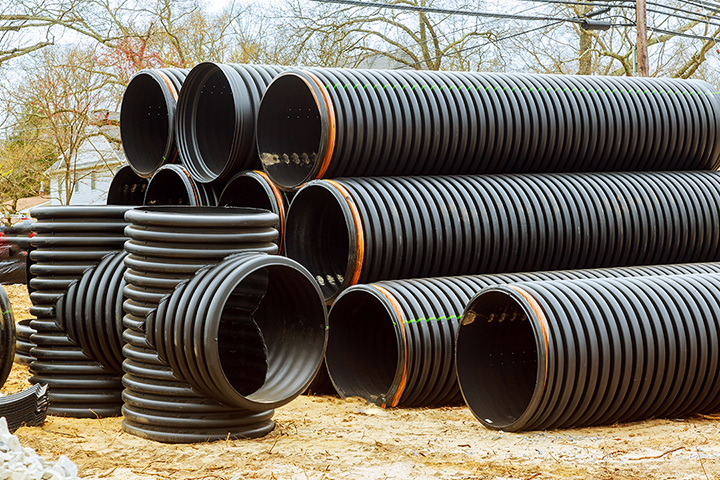The downstream oil and gas industry has seen significant changes in recent years, particularly in the materials used to manufacture piping. High-density polyethylene (HDPE) pipe has become increasingly popular due to its durability, flexibility, and long-term cost-effectiveness.
HDPE pipe is now widely used throughout the downstream sector, including in refineries, processing plants, and distribution networks. This shift represents a notable change in how oil and gas products are transported and managed after their extraction.
Why HDPE Pipes Are Best for Oil and Gas Operations
HDPE pipes have become the top choice for many oil and gas companies due to their unique properties and numerous advantages:
| Property | Description |
| Corrosion resistance | Doesn’t rust or corrode, even in harsh environments. |
| Chemical resistance | Withstands most hydrocarbons, acids, and bases in oil and gas. |
| Flexibility | Bends without breaking, ideal for unstable ground conditions. |
| Leak-Free Joints | Fusion joining creates a monolithic pipeline system. |
| Lightweight | Easier to transport and handle than metal pipes. |
| Abrasion Resistant | Maintains integrity when handling abrasive fluids and slurries. |
| Low maintenance | Requires less frequent inspections and repairs. |
| Longevity | Can last 50+ years when properly installed. |
| Cost-Effective | Lower installation and maintenance costs than traditional materials. |
| Operational Efficiency | Smooth interior surfaces maintain consistent flow rates. |
These properties offer significant advantages in oil and gas operations:
- Safety and Environmental Protection: HDPE’s resistance to corrosion and chemicals reduces the risk of leaks and spills, protecting both workers and the environment.
- Cost-Effectiveness: Lower maintenance needs, longer lifespan, and easier installation make HDPE a smart long-term investment.
- Operational Efficiency: The combination of smooth interiors, flexibility, and durability contributes to more efficient and reliable operations.
- Sustainability: A long lifespan reduces replacement frequency, and HDPE is recyclable at the end of its service life, aligning with growing environmental concerns in the industry.
From gathering lines to processing plants and distribution networks, HDPE pipes offer a reliable, efficient, and cost-effective solution for the demanding needs of the oil and gas industry. This unique combination of properties makes HDPE the best choice for many applications in this challenging sector.
Key Specifications for HDPE Pipe in Oil and Gas
When choosing HDPE pipes for oil and gas jobs, you need to make sure they meet certain standards. These standards ensure the pipes can handle the job at hand. Let’s break it down:
1. Material Grade: PE4710
PE4710 is the go-to material for HDPE pipes in oil and gas. It’s considered the superhero of plastic pipes. Here’s why this pipe is so multipurpose:
- Superior stress crack resistance: PE4710 can handle a lot of stress without cracking. This is critical because pipes in oil fields are constantly under pressure and stress.
- Excellent long-term strength: These pipes don’t get weak over time. They maintain their strength for decades, which is great for companies that want to avoid frequent pipe replacements.
- Enhanced pressure ratings: Oil and gas often move through pipes at high pressure. PE4710 can take this pressure without bursting, making it safer and more reliable.
Using this high-performance material means fewer leaks, less maintenance, and pipes that last longer. The superior stress crack resistance, long-term strength, and enhanced pressure ratings of PE4710 make it ideal for the demanding conditions in oil and gas operations.
2. Manufacturing Standards: ASTM F2619 and API 15LE
Manufacturing standards are like rulebooks – they ensure every pipe is made according to industry specification:
- ASTM F2619: This standard tells manufacturers exactly how to make HDPE pipes for oil and gas. It covers things like pipe thickness, strength requirements, and testing methods.
- API 15LE: This is another set of rules for making PE pipes. It’s specifically for the oil and gas industry and includes extra tests to ensure the pipes can handle tough conditions.
Following ASTM F2619 and API 15LE means every pipe is made to the same high quality. This reduces the risk of getting a “bad batch” of pipes that could fail.
3. Performance Requirements
These are tests that High-density polyethylene (HDPE) pipe must pass to prove they’re tough enough for oil and gas work:
- Hydrostatic Design Basis (HDB) performance: This test measures how much internal pressure the pipe can handle over time. It’s like testing how much air you can put in a balloon before it pops, but for years instead of minutes.
- Slow Crack Growth (SCG) resistance: This test checks if tiny cracks in the pipe will grow over time. Good HDPE pipes resist this, staying strong even with minimal damage.
- Rapid Crack Propagation (RCP) resistance: This test is about stopping cracks from spreading fast if the pipe gets damaged. It’s like making sure a small tear in your jeans doesn’t suddenly rip the whole leg.
These tests make sure the pipes can handle real-world conditions. They help predict how the pipes will perform over many years, even under rugged conditions.
How to Select the Proper HDPE Pipe for Oil and Gas Applications
Choosing the right HDPE pipe for your oil and gas project is critical. It’s like picking the right tool for a job – you want to make sure it can handle the work. Here’s what you need to think about when selecting an HDPE pipet:
1. Pressure Rating
This is how much pressure the pipe can handle without bursting. It’s like checking how much weight a bridge can hold. Before selecting your pipe, consider the following factors:
- The highest pressure your oil or gas will be at during transport.
- Any pressure spikes that might happen during use.
Then, to be safe, choose a pipe with a pressure rating slightly higher than what you need.
2. Temperature Range
HDPE pipes can handle different temperatures, but you need to pick the right one. Consider the following:
- How hot or cold your oil or gas will be when flowing through the pipe.
- The temperature of the ground where the pipe will be installed.
- Any extreme weather that might affect the pipe.
3. Chemical Resistance
Oil and gas are composed of multiple chemicals that are very corrosive. You need to make sure your pipe won’t get eaten away. Before selecting an HDPE pipe, consider the following:
- The material that will be flowing through your pipe.
- If the transported material contains harsh chemicals that might damage the pipe’s interior coating.
Ask the pipe manufacturer for a chemical resistance chart to help you determine which HDPE pipe is needed for the job at hand.
4. Diameter and Wall Thickness
The size of the pipe you select and its wall thickness is important because:
- The pipe’s diameter affects how much oil or gas can flow through it.
- The wall thickness of a pipe helps determine its strength.
Consult a professional if you are unsure which diameter or wall thickness your job requires. Balancing flow and strength is important within the downstream sector.
5. Joining Method
HDPE pipes need to be joined together. There are a few ways to do this:
- Butt fusion: This is like melting the ends of two pipes together.
- Electrofusion: This uses electrical current to join pipes.
Before you select the method you will use, consider your project’s scope and location. Both parameters can help you determine what joining method to use on your pipes.
6. Material Grade
The Plastics Pipe Institute (PPI) says you should use PE4710 for oil and gas jobs. This is important because:
- PE4710 pipe is manufactured from a durable material that is meant to last a long time.
- The material used in this pipe grade has been tested and approved for oil and gas work
- PE4710 meets all the industry standards.
7. Manufacturing Standards
Make sure your pipes are manufactured according to the following industry standards:
- ASTM F2619: This is a set of rules for manufacturing HDPE pipes that will be used in the oil and gas industries.
- API 15LE: A set of rules that lay out specifications for the manufacture of oil and gas pipes.
The standards mentioned above help make sure the pipes used within the oil and gas industry are high-quality and durable enough to withstand rugged conditions.
8. Quality Checks
To ensure that you are purchasing high-quality pipes, look for the following:
- Pipes that are marked to show they meet industry standards.
- Manufacturers who test their pipes thoroughly and are transparent with the results.
- Companies that provide paperwork proving their pipes are good and/or warranties on all products sold.
9. Manufacturer Reputation
Choose a pipe maker with a stellar reputation and experience within the industry:
- Look for companies with experience manufacturing oil and gas pipes.
- Check if the manufacturer is a member of groups like the Plastics Pipe Institute (PPI).
- Ask for references or case studies of their pipes in the field.
Remember, picking the right HDPE pipe is critical. It keeps your oil and gas flowing safely, prevents leaks, and saves you money in the long run. If you’re not sure about the type of pipe you should use, it’s always a good idea to ask an industry expert or the pipe manufacturer for help. They can help you make the best choice for your specific project.
Case Study: HDPE Pipes in Eagle Ford Shale Operations
The Eagle Ford Shale region, known for its bustling oil and gas activity, was an early adopter of High-Density Polyethylene (HDPE) pipes. While the American Society of Civil Engineers (ASCE) has studied the application of these pipes in both municipal and industrial projects, recent developments highlight their growing importance in the area’s oil and gas infrastructure.
HDPE pipes are gaining popularity in oil and gas work for several key reasons:
- The pipes are long-lasting and durable.
- The pipes are resistant to corrosion.
- The pipes are easy to install.
- It is cost-effective to transport and set up the pipes.
- The pipes can withstand high temperatures.
A notable example of HDPE pipe application in the Eagle Ford Shale is a major water infrastructure project. Chevron Phillips‘ Performance Pipe division is supplying their specialized “PlatinumStripe 1800 Series PE-RT Piping” for a 300-mile pipeline. This pipeline will transport the water produced from oil and gas operations to disposal facilities.
The benefits of using HDPE pipes for this project include:
- Superior resistance to corrosion from high-temperature produced water (160-180°F.
- Reduced transportation and installation costs compared to steel pipes.
- Significant reduction in heavy-duty truck traffic, potentially cutting 250,000 truck trips per year.
- Lower environmental impact, making it a more sustainable choice for oil and gas infrastructure.
This case demonstrates how HDPE pipes are not just theoretically beneficial but are being practically applied to solve real challenges in the oil and gas industry. The use of HDPE pipes in the Eagle Ford Shale region is a testament to their versatility and effectiveness in handling the demanding conditions of modern oil and gas operations.
Quality Assurance and Traceability for HDPE Pipes in Oil and Gas Applications
The Plastics Pipe Institute (PPI) emphasizes the importance of proper specification and quality assurance for HDPE pipes in oil and gas applications. To ensure the highest quality HDPE pipe, look for manufacturers who adhere to the following guidelines:
- The manufacturer uses the PE4710 compound, as required by industry standards.
- The pipe is manufactured according to ASTM F2619 and/or API 15LE standards.
- The manufacturer uses PPI PE4710 compound, as listed in Technical Report TR-4.
- The pipe is marked to demonstrate compliance with industry standards and to provide traceability to specific raw material batches.
- The manufacturer has a quality assurance program for both incoming materials and finished products.
- The manufacturer has a complete record retention system.
- The manufacturer can provide Certification of Conformance letters upon request.
- Quality assurance test data is available as required by industry standards.
These measures ensure that High-density polyethylene (HDPE) pipes can withstand demanding service conditions over long periods, which is critical for the growing oil and gas gathering market in North America. By following these guidelines, end users can confidently source high-quality HDPE pipes that meet or exceed industry standards, leading to successful installations with long service lives.
The Future of HDPE Pipe in Oil and Gas
As the oil and gas industry continues to evolve, HDPE pipe is poised to play an even larger role. Ongoing research and development within this sector is focused on:
- Enhancing HDPE pipe’s high-temperature performance.
- Improving the chemical resistance of HDPE pipes.
- Developing advanced composite HDPE pipes.
These advancements will further expand the applications of HDPE pipes in the downstream oil and gas sector.
Choose Coastal Resource Group for Your HDPE Pipe Needs
At Coastal Resource Group, we specialize in supplying high-quality HDPE pipes for oil and gas applications. Working with our team has several advantages, including:
- A comprehensive inventory of PE4710 HDPE pipes.
- 24/7 availability for emergency supply needs.
- Expert technical support and product selection assistance.
- Fast delivery to locations across East Texas (including Houston) and Central & West Texas (including Seguin)
Don’t let supply issues stall your project. Contact Coastal Resource Group today at (281) 549-4132 for all your HDPE pipe needs in the downstream oil and gas industry. We’re here to keep your operations flowing smoothly.


